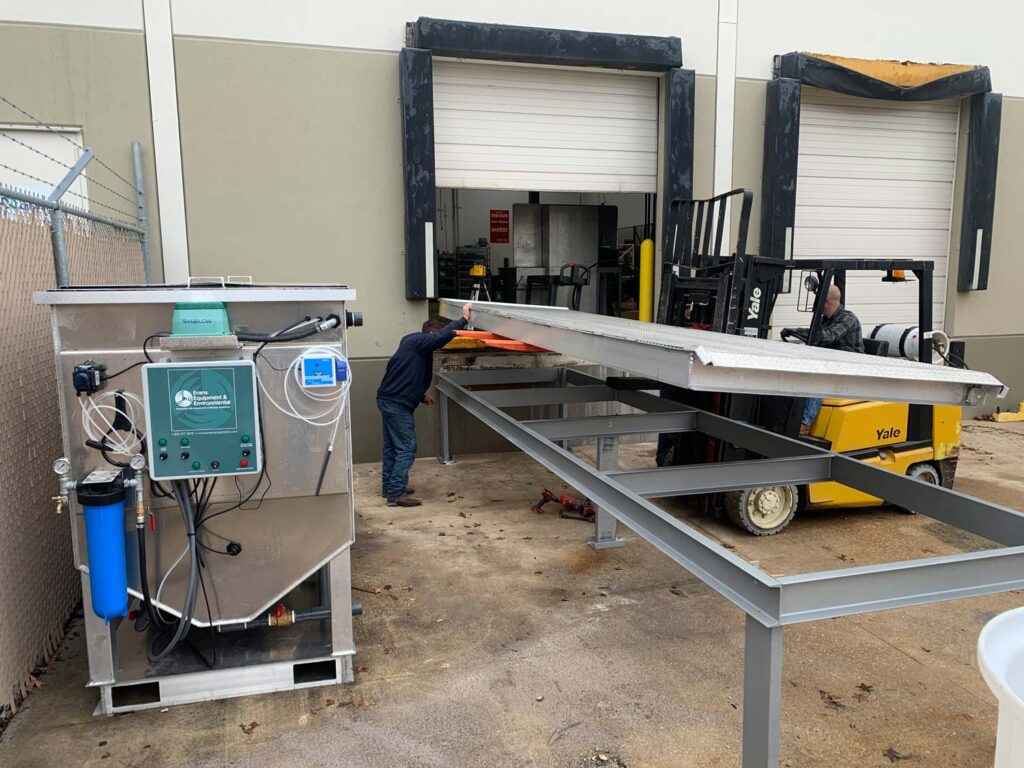STAY CONNECTED
Signup for our blog to receive tips and knowledge on industrial wash and wastewater treatment best practices.
Work with Us
Don’t settle for less than a solution from a partner who takes complete responsibility from start to finish. We make it easy to keep things clean and compliance effortless. Contact us today to discuss your wastewater treatment and industrial wash needs.

03/31/2023
Does Your Wash Water System Match Your Business Needs?

Equipment washing systems have come a long way in recent years. Proper wash system design and operation is critical to both effective washing and managing associated cost.
While the equipment wash system includes both the wash pump and accessories along with the wash water processing system. This post is focused on the wash water system alone as the options and system designs seem to cause more confusion in the market for our customers.
Wash water streams are not all the same. Your wash system wastewater will have various contaminants depending upon what you are cleaning, where and how it has been operating.
You may be processing hydrocarbons, toxic inorganic chemicals, liquids, fine powders or heavy coarse sand. Most often you have a combination of any or all of the varying water contaminants.
When was your last wastewater evaluation?
A large number of businesses that operate a wash system have designs in place that haven’t been updated in many years. The specific contaminants being washed may have changed or the system operating effectiveness may have degraded due to age and maintenance needs. But whatever your situation, it is important to evaluate your wash water system periodically to assure that it matches your current and future business needs.
What’s in your water?
A critical item in properly evaluating your wash water system is to understand what is in the wash water.
You need look at the make-up of your water in two ways; solids content and chemical composition.
Solids Content
Solids content will tell you the concentration, size and type of solids you need to remove from the water. If you have a substantial solids component, the wash water treatment system needs specific capabilities to handle those solids. A system lacking in adequate solids capacity may clog, overflow, require excessive maintenance or all three. The consequences can be expensive or worse unsafe.
There are a variety of filtration and settling design options that will allow your wash system to both properly handle wash water and make maintenance a planned and manageable event.
Chemical Composition
Chemical composition is important to understand to properly treat wastewater for a safe and effective wash system. Hydrocarbons such as grease and oil are common contaminants when cleaning machinery and there are many closed loop treatment solutions that are perfect for handling the water very effectively. Some chemicals found in industrial settings such as the cleaning of industrial process equipment may justify differing wash water treatment options.
The nature of the contaminants being washed also influences what cleaning agents may be best to support an effective system and should also be an important part of evaluating the best overall system design.
Another important element of your wash system included in any comprehensive evaluation is the source and volume of your wash water. How important is it to minimize water consumption and water supply make up? What kind of capacity or load does your wash system need to accommodate? What wastewater disposal options are available for a given wash location?
Water Consumption
Water consumption is pretty simple to evaluate. If you have an unlimited supply of free water, you may not be concerned with water consumption. If you pay for water and have any concerns about managing waste produced by your business, you likely want to minimize water consumption. Various wastewater capture and treatment solutions will require differing water makeup requirements so should be an important part of your system review.
Wash System Capacity
There are two main issues in evaluating system capacity. The more you use the system, the greater the required capacity. The more contaminants being washed from the equipment, the greater the required capacity. Both volume and contamination can increase the capacity required by your wash system so it is important to have a good understanding of both.
The consequence of an undersized wash system includes poor wash results, higher maintenance costs, safety risks and potential for non-compliant environmental performance.
Wastewater Disposal Options
While closed-loop water treatment systems are effective and common, some businesses still pay to have wastewater collected, shipped, and disposed of by a contractor. There are circumstances that require contract wastewater/solid waste disposal. There are also many applications where a business can operate a closed loop that allows using the same recycled and treated wash water; thus, minimizing the need to pay for either make up water or disposal of contaminated waste.
Evaluating whether your system would be best suited for a closed loop or contract disposal can save your business a lot in water consumption and save a lot of expense in disposal costs if a closed loop can be applied.
Proper wash system design and operation will assure you minimize the operating costs of whichever water processing system you use.